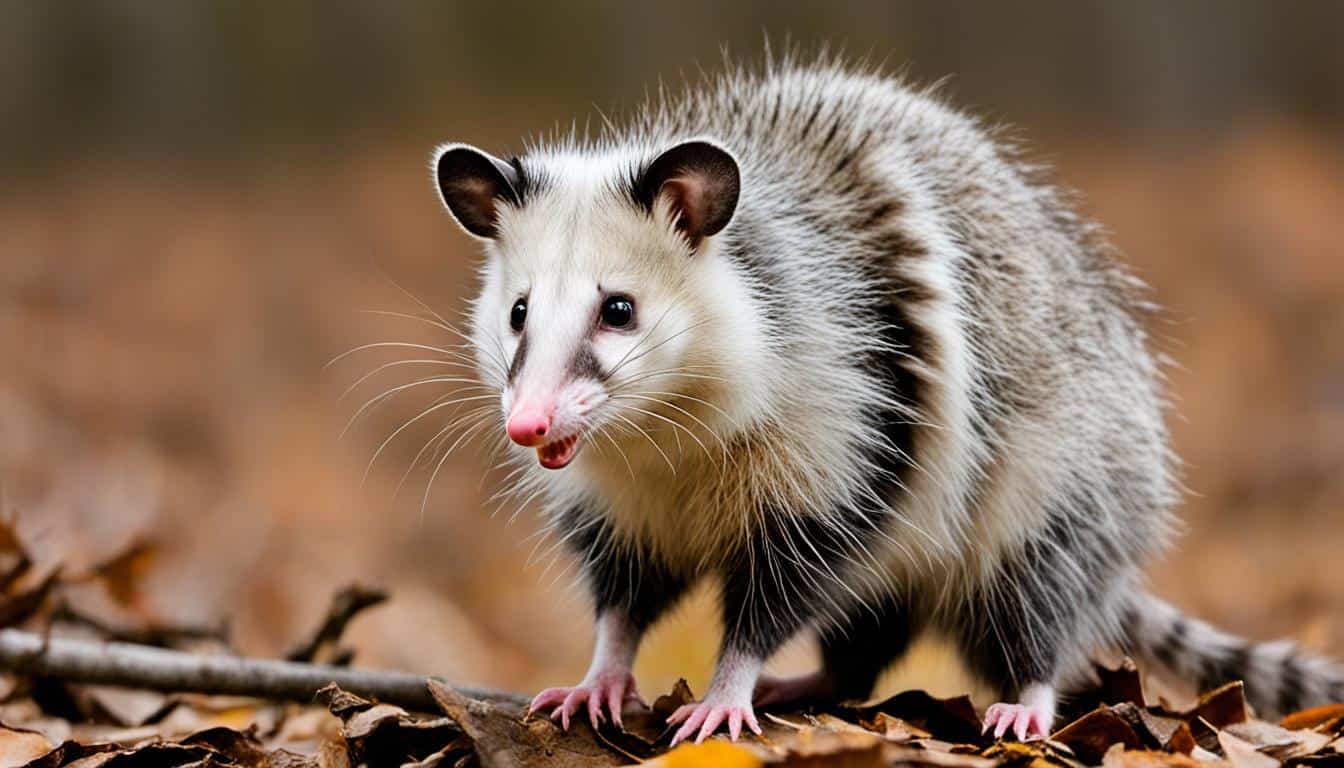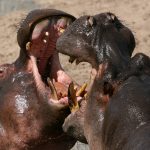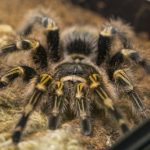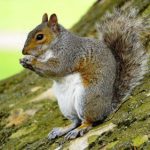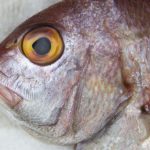Spotting a Virginia opossum means knowing what makes them stand out. They are the only marsupials north of Mexico. They’re about the size of a cat with unique snouts and tails.
To tell them apart, look at their bodies, watch how they act, and the prints they make. Knowing these details makes you value their place in nature.
Overview of the Virginia Opossum
The Virginia opossum (Didelphis virginiana) is a remarkable creature found widely in North America. They are known for unique features and behaviors.
Introduction to Virginia Opossum (Didelphis virginiana)
It’s quite easy to spot a Virginia opossum once you note their key traits. They are praised for their ruggedness and adaptability, spanning from south Canada to Costa Rica. Their prehensile tails and sharp snouts make them stand out.
Range and Habitat
The Didelphis virginiana range spans from places with mild weather to subtropical areas. They can live in many spots as long as there’s water. It’s also interesting to note they can be seen in some parts of Canada due to human introduction.
Virginia opossums are typically active at night and prefer to be alone. This lifestyle, along with their ability to eat almost anything, helps them thrive in various places. Their ability to adapt their diet is a big plus.
| Region | Presence |
|---|---|
| Southern Canada | Yes |
| United States | Yes |
| Costa Rica | Yes |
| Western Canada (Introduced) | Yes |
| Pacific Coast (Introduced) | Yes |
Physical Characteristics of Virginia Opossum
Virginia opossums stand out with their unique looks. They are interesting for anyone who loves nature. Let’s explore what makes them special.
Size and Weight
Virginia opossums come in different sizes depending on where they live. Those in the north are usually bigger. Males can reach about 40 inches long from their nose to the tip of their tail. Females are a bit smaller than males.
Color and Coat Patterns
Virginia opossums are mostly grayish-brown with white faces. You’ll notice their black ears and feet. This coloring makes them quite distinctive.
Unique Physical Features
These animals have a special trait—a long, hairless tail that helps them climb. They also have thumbs on their back feet that are helpful for climbing. They have more teeth than any other mammal in North America. Their toes have sharp claws but their hind feet’s thumbs are clawless.
| Feature | Description |
|---|---|
| Size & Weight | Vary by geographic location; males typically 40 inches in length. |
| Color & Coat Patterns | Dull grayish-brown with white faces, black ears, and feet. |
| Prehensile Tail | Long, hairless, aids in climbing. |
| Opposable Thumbs | Found on hind feet, improve climbing and grasping abilities. |
| Dental Structure | More teeth than any other North American land mammal. |
How do you identify a Virginia opossum?
Spotting a Virginia opossum means looking at how it looks and acts. Their coat is a big clue. Look for a dull grayish-brown body with a white face and black ears.
They also have a unique tail. It’s able to grab things and doesn’t have hair. This tail sets them apart from other marsupials in North America.
How they behave is another hint. Virginia opossums pretend to be dead when scared. This makes them look like they’re not alive and they smell bad on purpose to scare off enemies.
Looking at the ground can reveal more. Opossum tracks usually have five toes. The back feet have a thumb they can use like a finger. Their walking style is often described as a waddle or a pace.
| Characteristic | Details |
|---|---|
| Coat Patterns | Dull grayish-brown body, white face, black ears |
| Tail | Prehensile, hairless |
| Behavior | “Playing dead,” emitting foul odor |
| Tracks | Five toes on front and hind feet, opposable thumb on hind |
Watching what they eat is key too. Virginia opossums eat almost anything. This includes fruits, bugs, small animals, and even dead animals. Their eating habits show that they can live in many places.
Behavioral Traits of Virginia Opossum
The Virginia opossum is known for its unique behaviors. These traits help it live in many different places. Knowing about these behaviors tells us more about their life and how they adapt.
Nocturnal Habits
The Virginia opossum is active at night, making it quite fascinating. Being active at night helps it avoid competing for food and stay away from predators. These creatures are skilled at finding food in the dark, using their keen senses.
Diet and Feeding Habits
Virginia opossums eat a wide variety of foods, making them omnivorous. They consume fruits, insects, birds, and dead animals. This ability to eat many different things is crucial for their success. They can even eat poisonous snakes because they are immune to their venom.
They’re great at finding food, which shows how they make the most of what’s around. Their diet reflects their opportunistic nature.
| Behavior | Details |
|---|---|
| Nocturnal Activity | Active at night, foraging and evading predators. |
| Virginia Opossum Diet | Omnivorous: fruits, insects, birds, carrion, and even poisonous snakes. |
| Foraging Skills | Excellent foragers, adaptable to various food sources. |
Virginia Opossum Reproduction
Learning about Virginia opossums’ reproduction opens a window into their intriguing life cycle. Key points include their mating season and the quick gestational period.
Mating Season
From January to July is the Virginia opossum mating season. Males often mate with many females during this time. This period is vital for their species, helping ensure young ones arrive when the environment supports their growth.
Gestation and Litter Size
Virginia opossum gestation lasts only 12 to 13 days. After this, female opossums can have litters of up to 25 young. Yet, only about seven or eight typically live, based on the mother’s pouch capacity for feeding. The babies latch onto a teat and stay there for about 50 to 55 days, after which they start becoming more independent.
This reproductive pattern is key for the Virginia opossum’s survival and its role in different habitats.
Virginia Opossum Tracks and Signs
Spotting Virginia opossums can be tricky. They leave behind footprints and other signs. Learning to look for these clues can make it easier to find them.
Footprints and Stride Pattern
Look for tracks with five toes and a thumb. Opossums walk in a specific way, which is called an aligned or pacing gait. This makes their footprints different from other animals.
Other Indicators of Presence
Virginia opossums also leave signs like scattered bones and fur. Finding these clues helps you understand where they are active. It gives a peek into their feeding habits too.
Recognizing a Virginia Opossum in the Wild
When trying to spot a Virginia opossum in the wild, take note of their unique features. Look for their long and hairless tail. This tail helps them hold onto branches and stay steady when climbing.
Notice how they walk. They move slowly and with purpose, sometimes in a unique way. Also, be alert for hissing sounds. They do this when they feel scared or upset.
It’s fascinating to watch them “play dead” as a defense. This means they lie still, with their mouth open and tongue out. They do this to make others think they’re already dead.
To better see a Virginia opossum, understand where they like to live. They prefer places with water and hiding spots. This makes places like forest edges, marshes, and even some neighborhoods good spots to look. Knowing their preferred habitats is key to finding them.
Below is a table summarizing important points about Virginia opossums:
| Trait | Description |
|---|---|
| Tail | Long, hairless, and prehensile |
| Gait | Slow, deliberate movements with a peculiar strut |
| Sound | Hissing noises when threatened |
| Defense Mechanism | “Playing dead” with slack jaw and protruding tongue |
| Habitat | Areas with water and shelter like forest edges and marshes |
Remember, these key traits will help you in spotting and understanding Virginia opossums. They show us amazing ways of living and protecting themselves in nature.
Virginia Opossum Defense Mechanisms
Virginia opossums rely on many ways to stay safe from harm. These methods they use are key to their survival. By learning about these defense methods, we gain a greater understanding of how diverse animals protect themselves.
Playing Dead
Playing dead is a top defense move for Virginia opossums. In face of danger, they go still and look lifeless. They do this by lying totally motionless, jaw slack, drips of drool, and the tongue out. This makes them seem dead to their enemies, who typically try not to eat things that look or smell dead.
Emitting Odors
These opossums also release a horrid green fluid from their behinds. This fluid smells so bad that it keeps predators away. So, not only do they pretend to be dead, they also stink themselves up. This is another strong part of their all-around defense mode.
Aggressive Displays
And if all this fails, Virginia opossums can get tough. They show off their sharp teeth, hiss, and fluff up. This makes them look fierce and not worth messing with. It’s another way they fend off danger.
Virginia Opossum’s Diet and Feeding Behavior
The Virginia opossum is an expert at eating a wide range of foods. This makes it able to live in many different places. It eats both plants and animals, making it an omnivore. Knowing about the Virginia opossum’s diet helps us see why it’s so successful.

Omnivorous Diet
This opossum eats a mix of plants and animals. Its diet includes things like fruits, veggies, nuts, and grains. It also eats bugs, worms, small mammals, birds, frogs, and sometimes snakes. It’s pretty cool that it’s not harmed by some snake venoms. This helps the opossum have more choices in what it eats.
Feeding Habits and Preferences
The Virginia opossum’s feeding habits are mostly at night. They look for food when it’s dark, always watching out. They are not fussy eaters, often eating dead animals or what people throw away. This ability to eat anything helps them live in many different places.
| Food Type | Examples | Importance in Diet |
|---|---|---|
| Fruits and Vegetables | Apples, Grapes, Carrots | High |
| Insects | Beetles, Crickets, Grasshoppers | Moderate |
| Small Animals | Mice, Birds, Frogs | Moderate |
| Scavenged Material | Carrion, Human Food Waste | High |
Virginia Opossum Common Misconceptions
Let’s clear up some popular misconceptions about the Virginia opossum. A big myth is that female opossums give birth through their noses. This idea comes from how these marsupials take care of their babies. The truth is, they give birth like other mammals do. Newborn opossums are small and not fully developed. They crawl into the mother’s pouch to feed and grow more.
Some people think newborn opossums can’t leave their mother’s nipple once they latch on. This isn’t true. While they do latch on for food and warmth, they are not stuck that way. They feed and stay warm in the pouch for about two months before leaving.
It’s important to correct these misconceptions about the opossum. Doing so helps us understand them better. Sharing the right information means better education about these animals. This way, we can help in saving them and making more people aware of their importance in nature.
FAQ
How do you identify a Virginia opossum?
Virginia opossums are about the size of a domestic cat, with a unique look. They have a hairless, grabby tail. Their coat is dull grayish-brown with a white face. You can spot them by their black ears and feet. They have opposable thumbs on their back feet. Surprisingly, they have more teeth than any other North American land mammal.
What is the range and habitat of the Virginia opossum?
These opossums are found from southern Canada down to Costa Rica. They also live in parts of western Canada and the Pacific coast “thanks to” human introductions. They like places near water but can live in many different landscapes.
What are the unique physical features of a Virginia opossum?
Virginia opossums stand out with their long, hairless tail which is good at grabbing things. They also have thumbs on their hind feet. This helps them climb and hang onto things. Their ears and feet are black, and they have sharp claws on their toes, except for their thumb. These features are pretty unique.
What are some typical behaviors exhibited by Virginia opossums?
Virginia opossums like to be active at night and usually keep to themselves. They go after food when they can find it, mostly during the night. When they’re scared, they might act like they’re dead to avoid danger. They look for places that have water, food, and somewhere safe to live.
When is the Virginia opossum’s mating season?
These opossums mate from January to July. The males have more than one partner. After 12 to 13 days of pregnancy, the females give birth.
How can you identify Virginia opossum tracks and signs?
To spot Virginia opossums, look for their unique tracks. Their footprints have five toes and an opposable thumb. Their hiding trick and marks left by looking for food can also show you they’re around.
What are the dietary habits of Virginia opossums?
These animals eat just about anything, from fruits to birds. They even snack on snakes. This shows how well they can eat all sorts of foods.
What are common misconceptions about Virginia opossums?
Some people think the wrong things about these opossums. They believe weird things like babies coming out of the mother’s nose. There’s also a myth that opossum babies get stuck on the mother’s nipple, which isn’t true.

